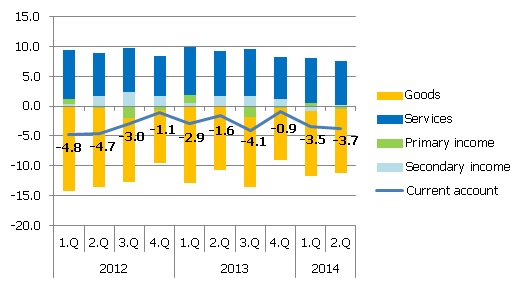Latvian current account deficit at 224 million euro
In the Latvian current account in the second quarter of 2014 there was a 224 million euro deficit (-3.7% from the projected gross domestic product (GDP), see Chart.). The deficit formed primarily as a result of international trade in goods deficit.
Chart. Main components of the current account (% of GDP)

* For the second quarter of 2014, the GDP projections of Latvijas Banka (6029.9 mil. euro) were used
The goods and services international trade deficit in the second quarter increased to 209.1 mil. euro (-3.5% from the predicted GDP). In the second quarter of 2014, international trade in goods deficit increased quarter-on-quarter, reaching 650.6 mil. euro, which can be explained by the fact that albeit goods exports posted a slight increase, goods imports increased at a faster rate during this period. Comparing the quarterly data in terms of percent of GDP, deficit shrank, albeit minimally, to -10.8% of the predicted GDP.
The positive balance of international trade in services increased to 441.5 mil. euro, fostered by the increase in services exports under the impact of seasonal factors in such areas as construction services abroad, technical, trade-related and other economic activity services, financial services paid for directly and other financial services, as well as other economic activity services. Comparing the data of the first and second quarters in terms of percentages of GDP, the positive balance of of international trade in services dropped to 7.3% of the projected GDP in the second quarter.
The balance of the primary income account in the second quarter of 2014 became negative quarter-on-quarter dropping to -26.5 mil. euro (-0.4% of the predicted GDP). The fluctuations in certain months were primarily influenced by a drop in the European Union (EU) fund subsidies received by Latvia. The balance of secondary income in the second quarter increased reaching 11.6 mil. euro (0.2% of the projected GDP), impacted by the reduced payments into the EU budget.
The positive balance of the capital account also grew in the second quarter of 2014, reaching 309.4 mil. euro (5.1% of the projected GDP). These changes were as usual promoted by the flows of EU financing earmarked for investments.
The financial account deficit increased to 374.6 mil. euro (-6.2% of projected GDP) as a result of transactions with debt securities and derived financial instruments. In April of this year, the Latvian government emitted euro securities in the amount of one billion euro in the international markets in order to re-finance the loan from the European Commission. Foreign direct investment in Latvia as a result of transactions was at 72.6 mil. euro (1.2% of projected GDP) in the second quarter. As has already been reported, at the end of May and beginning of June, Latvia's credit rating was improved by such rating agencies as "Standard&Poor's", "Fitch Ratings" and "Moody's Investors Service". Even though that fosters investors' interest and trust in the Latvian economy, uncertainty stemming from the Russian and Ukrainian political situation and Russian embargo on food products has grown.
Textual error
«… …»




